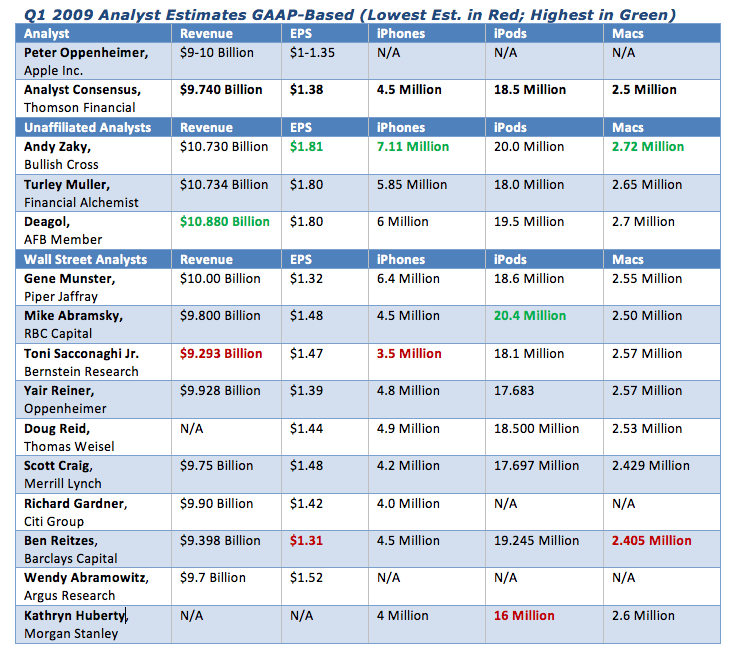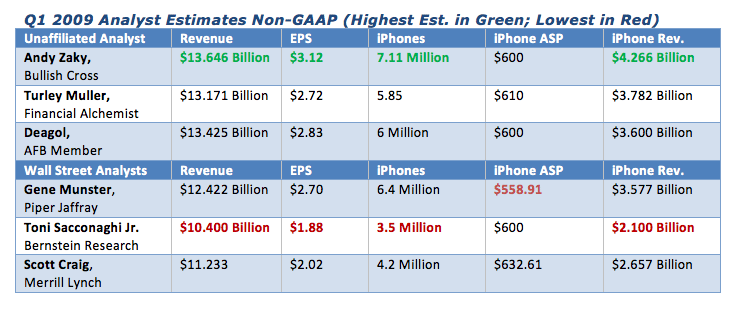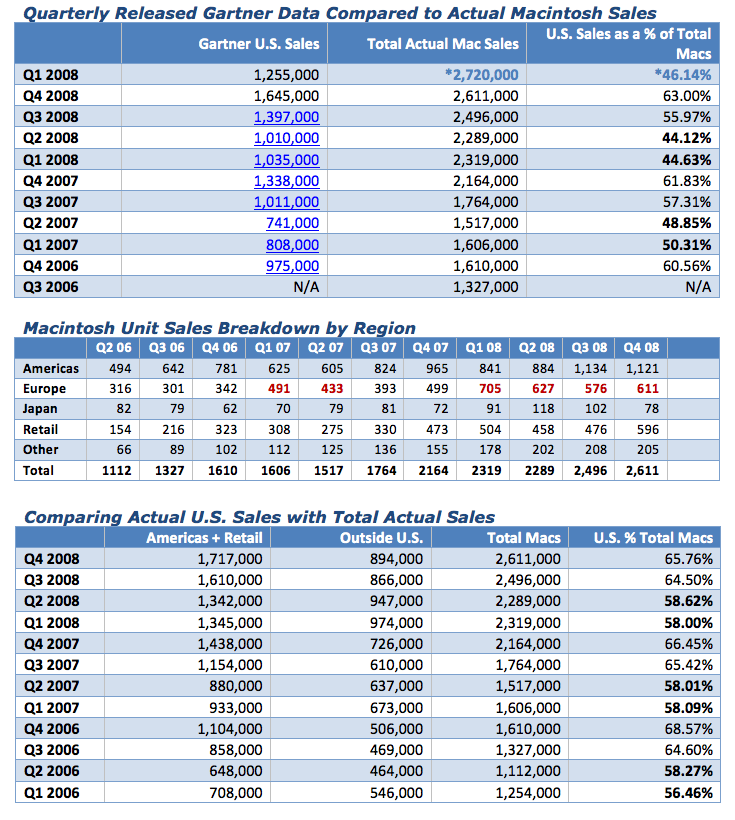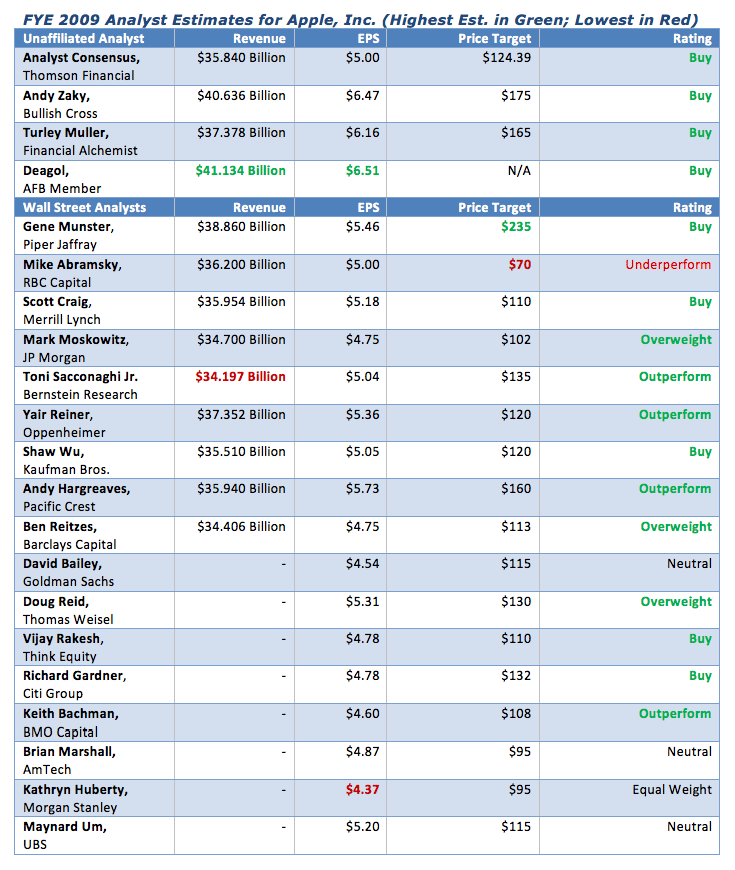On average, the analysts are looking for the Cupertino-based electronics maker to sell approximately 4.5 million iPhones, 18.5 million iPods and about 2.45 million Macs.
I’m looking for Apple to beat those expectations quite handedly. I expect Apple to report earnings of $1.81 in EPS on $10.730 billion in revenue driven in part by sales of 7.11 million iPhones, 20 million iPods and 2.72 million Macs. On a non-GAAP basis, I’m expecting Apple to report earnings of $3.12 in EPS on $13.646 billion in revenue driven by approximately $4.266 billion in fully recognized iPhone revenue.
The tables below outline my earnings forecast, and unit sales estimates for Apple’s first fiscal quarter of 2009:
At the outset of the quarter, I offered detailed arguments as to why there might be such a disparity between analyst consensus estimates and actual results (see here). I believe the analysts have gotten too carried away with the chopping of their estimates this quarter, and are letting the bear get the best of them. If previous earnings debacles didn't provide enough evidence to this end, then this quarter should be one for the books. All of the data in support of my estimates are available to the public at large. The table below outlines earnings estimates from several prominent Wall Street analysts along with a few rather accurate, but unaffiliated analysts.
While it was difficult to secure full estimates from Kathryn Huberty, her revenue expectations are likely quite low given the fact that she is once again modeling for apocalyptic iPod sales. This wouldn’t be the first time Huberty has modeled for the complete destruction of Apple’s financials, and it certainly won’t be the first time she is shown to be wrong either.
Also interesting is how all three unaffiliated analysts arrived at very tight estimates for Q1. Both Deagol from Mac Observer’s AFB (famous for his accuracy in forecasting based on his tracking of web orders is forecasting sales) and Turley Muller from the Financial Alchemist have come within a few million dollars in revenue of my own revenue estimates. Each of us is basically looking for $1.80 in EPS when Apple reports this afternoon.
In terms of non-GAAP earnings forecasts, several analysts including Yair Reiner and Ben Reitzes simply failed to provide estimates for Apple’s adjusted earnings in their research reports despite Apple's promise to report adjusted earnings on an on-going basis. I was able to secure non-GAAP revenue estimates from a few analysts however, and each is presented in the table below.
The table above highlights just how bearish some Wall Street analysts can be regarding Apple’s financial situation. Toni Sacconaghi’s non-GAAP estimates have risen to a level of skepticism unmatched by most other analysts. Sacconaghi’s non-GAAP revenue estimates are almost $400 million below the unaffiliated analyst consensus for GAAP-based revenue. If Apple does happen to report in-line with our expectations, Sacconaghi will have missed calling Apple’s revenue by more than $3 billion.
Macintosh Sales Estimate
I arrive at the 2.72 million Mac unit sales estimate based on interpreting quarterly data released by the Gartner Group on computer sales in the United States. I also use IDC and NPD data as secondary sources to compliment my primary analysis. Gartner data is especially helpful in that it typically predicts about 44-46% of Apple’s total sales during fiscal Q1 and Q4 while accurately predicting between 55-63% of Apple’s total Mac sales in Q2 and Q3 of any given fiscal year. While this quarter is unusual in that it is difficult to tell just how well Mac sales fared in Europe, the fact that Apple grew its U.S. sales rather dramatically on YoY basis might suggest that things are not as bad as they might seem. I place a lot less emphasis on NPD data because NPD focuses exclusively on retail chain store sales. Apple’s own retail has been growing at an explosive pace and to extrapolate Mac sales data from NPD findings places the analyst on rather dangerous grounds. Especially in an environment where retail sales are sinking and online sales are booming. To read a full in-depth analysis on this method of forecasting Mac sales, click here. Gartner data this quarter seems to suggest that Apple will post sales of 2.670 to 2.852 million Macs.
A Note on iPhone Sales Estimates
Last quarter, the analysts missed on their iPhone sales forecasts by an average of 72%. Even bullish analysts such as Gene Munster from Piper Jaffray missed iPhone estimates by close to 30%. The unaffiliated analysts, by contrast, all came within 8% of the actual number. The unaffiliated analysts arrive at their iPhone estimates by tracking IMEI data which unofficially tracks the actual production rate of the iPhone by analyzing the TACs or numbering system used by Apple.
At the end of November, IMEI data suggested that Apple had produced its 15 millionth 3G iPhone (spreadsheet). Yet, no data is available for the month of December so a lot guess work has to go into how might have happened in December. Since its debut Apple has produced, on average, about 3 million iPhones per month. If one conservatively assumes that Apple produced only 1 million iPhones in December (only 33% of the normal rate), that would put Apple at a total of 16 million 3G iPhones produced. If one subtracts the 3G iPhones Apple already reported as sold in Q4 2008 (6.89 million), one will arrive at a total of 9,110,000 iPhones that could have potentially been sold. However, one always has to assume that about 2 million iPhones are sitting in Apple’s inventory, are replacements for defective iPhones, or are damaged during the manufacturing process. Thus, if one subtracts about 2 million iPhones from the total potential sales for the quarter, one would arrive at 7.11 million iPhone sales. Read more about this method of forecasting iPhone sales here.
Analyst FY 2009 Earnings Forecast for Apple, Inc.
While investors should rightly focus on Apple’s Q1 earnings results out after the market closes today, I think it’s important to hold analysts accountable for their obvious errors in forecasting 2009 earnings results. So before analysts are quick to adjust the FY 2009 estimates after Apple reports today, I thought it would be nice to remind everyone how these analysts have handled themselves over the past few months. The table below outlines several Wall Street analyst estimates, price targets and buy ratings for FY 2009. I find it interesting that it’s a lot easier to locate a Wall Street analyst’s FY 2009 estimate than it is to find that same analyst’s estimate for the current accounting period.
 Andy M. Zaky, Bullish Cross, Special to AppleInsider
Andy M. Zaky, Bullish Cross, Special to AppleInsider











-m.jpg)






 Marko Zivkovic
Marko Zivkovic
 Andrew Orr
Andrew Orr
 Amber Neely
Amber Neely

 William Gallagher and Mike Wuerthele
William Gallagher and Mike Wuerthele












3 Comments
My analysts shows these analysts maybe wrong or they maybe right, , but I'm only guessing … oh, that's what they are doing as well.
Who do I see to pick up my pay check?
Skip
While investors should rightly focus on Apple?s Q1 earnings results out after the market closes today, I think it?s important to hold analysts accountable for their
Heh heh. One can only wish. Maybe some day day, banks will compensate analysts based solely on their predictions......
Actual
• Apple today posted revenue of $10.17 billion and net quarterly profit of $1.61 billion, or $1.78 per diluted share
• Non-GAAP: $11.8 billion of "Adjusted Sales" and $2.3 billion of "Adjusted Net Income"
• sold 2.524 million Macs, 22.727 million iPods, 4.363 million iPhone units
Lesson:
When you make enough predictions, you are bound to make a lot of incorrect ones, especially when based solely on other projections. Prior close predictions do not guarantee accuracy of future predictions,
The sad fact is that most so-called "tech news" today are based mainly on speculations and projections rather than actual data or scientific or statistical projections.